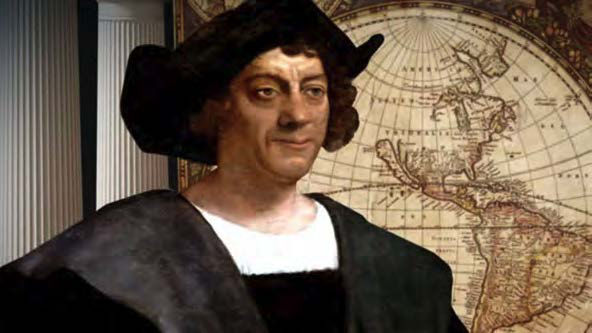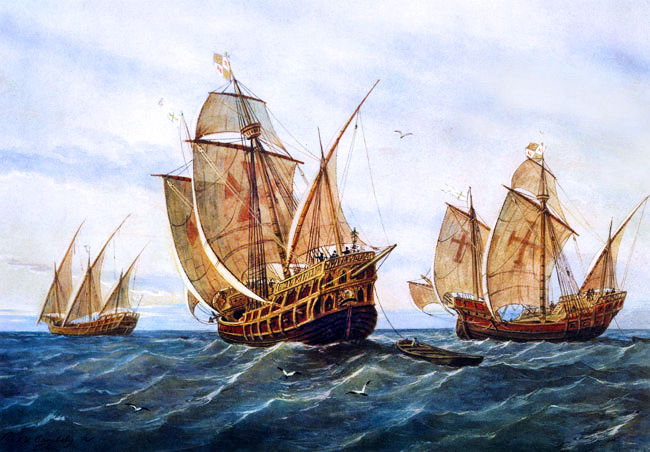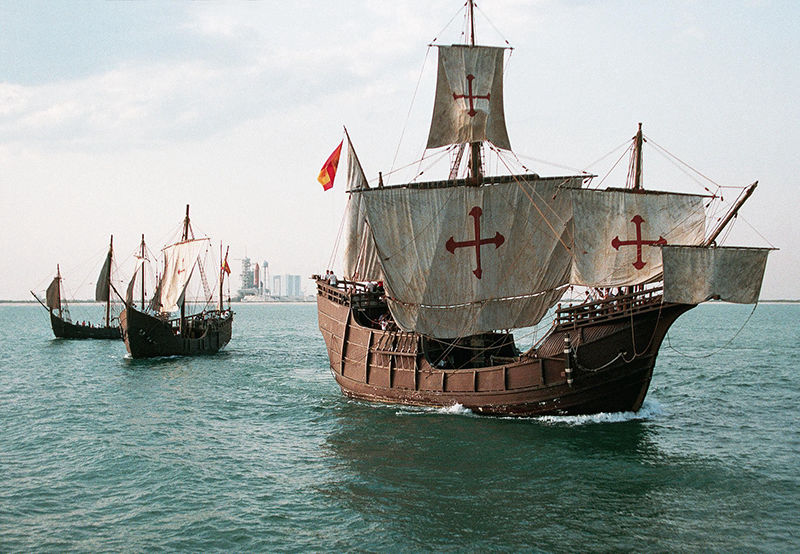
We have studied what is called ‘physical’ geography; but there is more than one area of geography which we can study.
What it is that called?
It’s called ‘human geography’.
Human geography studies the effects that humans - that’s us - have on the world; the good things and the bad things on the actual physical surface (such as rising ocean levels). It’s also connected with how one set of humans have on another.
The first type we will look at is how one set of humans affect another. It’s not about how a few people affect a few other people, it’s about how one ‘population’ affects another.
I hope very much that you’ve all heard of Christopher Columbus. Here’s a picture of him.

As you can see, he’s not exactly a ‘modern’ person.
What did he discover?
So many people think that he did discover the American continent, but in fact he probably didn’t. More recent thoughts are that the Vikings were there first, and even some ideas suggest that Aboriginals from Australia were there even before the Vikings.
The point is not really if he discovered the American continent or not; but what happened when he arrived.
The movie ‘Apocalypto’ is a very good film about an indigenous American tribe.
What does the word ‘indigenous’ mean?
It means those people who were originally occupying a place - such as the original Americans, the Aborigines, or the Celts.
The relevance of this film is that it shows how life was before the influence of European people.
Does anyone know from which country Columbus came?
He was actually Italian but his travels and explorations were financed by Queen Isabella from Spain; so people often get confused.
Columbus brought many ideas and even objects from Europe (he went in a convoy of three ships, with others to follow). Here’s a picture of the first three - the Nina, the Pinta and the Santa Maria.

These were small ships; here’s a picture of modern reproductions of them:

Columbus and his men sailed all the way across the Atlantic, about 7500 km, mostly in fear they were going to fall off the edge of the world.
The European culture which Columbus took with him was absorbed into American culture.
Why might that be a bad thing?
Because some things were imposed on the American population - such as religion, and the way of life of the original people was forever changed by the influence of how the Europeans lived.
The indigenous population had a completely well functioning society and way of life; they had their traditions which were often thousands of years older than those of the Europeans, but the Europeans had one type of thing which the Americans didn’t.
Does anyone know what that was?
Firearms. They had guns. And no matter how fast you run, you can’t run faster than a bullet. The Americans had spears and sharpened sticks - even with poison; but you can dodge and run about to avoid a spear.
That really sums up the problem of when one population meets another - the chances are that one will be more advanced in some way than the other and can take the first one over.
If you think about it, if aliens ever arrived on Earth, who’s likely to be most advanced?
A civilisation which has travelled billions of miles - maybe light years - is not going to be inferior to us. The mere fact that they have travelled across space - when we’ve just about made it to the moon (and even that not for almost 50 years.
So, Columbus arrived, with good intentions, but there’s an idiom we often use about ‘good intentions’.
Does anyone know what it is?
Good intentions can have bad results.
The good intentions Columbus had were to increase the well-being of the natives, as we shouldn’t call them, and also to ‘improve’ their lives with European culture.
Naturally, Queen Isabella wanted something out of it all, and of course Columbus was also hunting for treasure. Which he found in vast quantities.
What is the substance looked for mainly as ‘treasure’?
Gold!
The Americans used gold for many purposes, ceremonial, of course but also in everyday objects. No one is quite sure where they found their gold but they had plenty of it.
You can imagine how the eyes of Columbus (and other Europeans) glittered when they saw how easily gold was available; it was pay day in a big way! By bartering and bargaining, Columbus obtained enough gold to pay back Queen Isabella.
What is ‘bartering’?
It is basically arranging to swap or exchange one product for another or value which the other person thinks is worth it.
Moving on from financial things, there were other parts of each culture which could be exchanged. Here’s a thing: Where did tomatoes come from originally?
America! Which means the American continents, both north and south.
Tomatoes became a staple ingredient in Italian food (think of pizza). What about potatoes? We all know that British people eat lots of potatoes, but they too originally came from South America.
Now, there were two types of impact that the intrusion of Europeans had on the natives. Simply, short and long term impacts of various types. That's on another page.